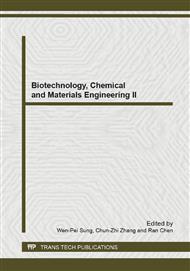[1]
B. M. Rice, S. Sahu and F. J. Owens, Density functional calculatios of bond dissociation energies for NO2 scission in some nitroaroamtic molecules, J. Mol. Struct. (Theochem). 583(2002) 69-72.
DOI: 10.1016/s0166-1280(01)00782-5
Google Scholar
[2]
A. Delpuech and J. Cherville, Proc. Symp. Chem. Probl. Connected Stab. Explos. (1976).
Google Scholar
[3]
A. Delpuech and J. Cherville, Relation entre la Structure Electronique et la Sensibilité au Choc des Explosifs Secondaires Nitrés-Critère Moléculaire de Sensibilité. I. Cas des Nitroaromatiques et des Nitramines, Propellants Explos. 3(1978).
DOI: 10.1002/prep.19780030605
Google Scholar
[4]
A. Delpuech and J. Cherville, Relation entre La Structure Electronique et la Sensibilité au Choc des Explosifs Secondaires Nitrés. III. Influence de l'environnement cristallin, Propellants Explos, 4(1978) 61-65.
DOI: 10.1002/prep.19790040306
Google Scholar
[5]
F. J. Owens, K. Jayasurya, L. Abrahmsen, et al. Computational analysis of some properties associated with the nitro groups in polynitroaromatic molecules, Chem. Phys. Lett. 116(198) 434-438.
DOI: 10.1016/0009-2614(85)80199-8
Google Scholar
[6]
H. Xiao: Molecular Orbital Theory of Nitro-compound (Publishing House of Defense Industry, China 1994).
Google Scholar
[7]
X. S. Song, X. L. Cheng, X. D. Yang, et al. Relationship between the Bond Dissociation Energies and Impact Sensitivities of Some Nitro-Explosives, Prop. Explos. Pyrotech. 31(2006) 306-310.
DOI: 10.1002/prep.200600042
Google Scholar
[8]
J. Leszczynski: Computational Chemistry: Reviews of Current Trends (World Scientific, River Edge NJ 1999).
Google Scholar
[9]
P. Capkova, M Pospisil, P. Vavra and S. Zeman, In: Energetic Materials Part 2. Detonation, Combustion, edited by P. Politzer and J. S. Murray, Characterisation of Explosive Materials Using Molecular Dynamics Sumlations, chapter, 2, Elsevier (2003).
Google Scholar
[10]
M. J. Kamlet and H. G. Adolph, The relationship of Impact Sensitivity with Structure of Organic High Explosives. II. Polynitroaromatic explosives, Prop. Explos. Pyrotech. 4(1979)30-34.
DOI: 10.1002/prep.19790040204
Google Scholar
[11]
L. R. Bates: Proc. 13th Symp. Explos. Protech. (1986).
Google Scholar
[12]
C. Zhang, Y. Shu, Y. Huang, et al. Investigation of Correlation between Impact Sensitivities and Nitro Group Charges in Nitro Compounds, J. Phys. Chem. B, 109(2005) 8978-8982.
DOI: 10.1021/jp0512309
Google Scholar
[13]
R. S. Mulliken, Electronic Population Analysis on LCAO-MO Molecular Wave Functions, J. Chem. Phys. 23(1955)1833-1840.
DOI: 10.1063/1.1740588
Google Scholar
[14]
M. Dewar and W. Thiel, Ground states of molecules. 38. The MNDO method. Approximations and parameters, J. Am. Chem. Soc. 99(1977) 4899-4907.
DOI: 10.1021/ja00457a004
Google Scholar
[15]
Sybyl 6. 6. 2.; Tripos Inc., (2000).
Google Scholar
[16]
L. M. Hall, L. H. Hall and L. B. Kier, QSAR modeling of β-lactam binding to human serum proteins, J. Comp. -Aided Mol. Des. 17(2003)103-118.
Google Scholar
[17]
L. Xu: Chemometrical Method (Scientific Press, China 1996).
Google Scholar


